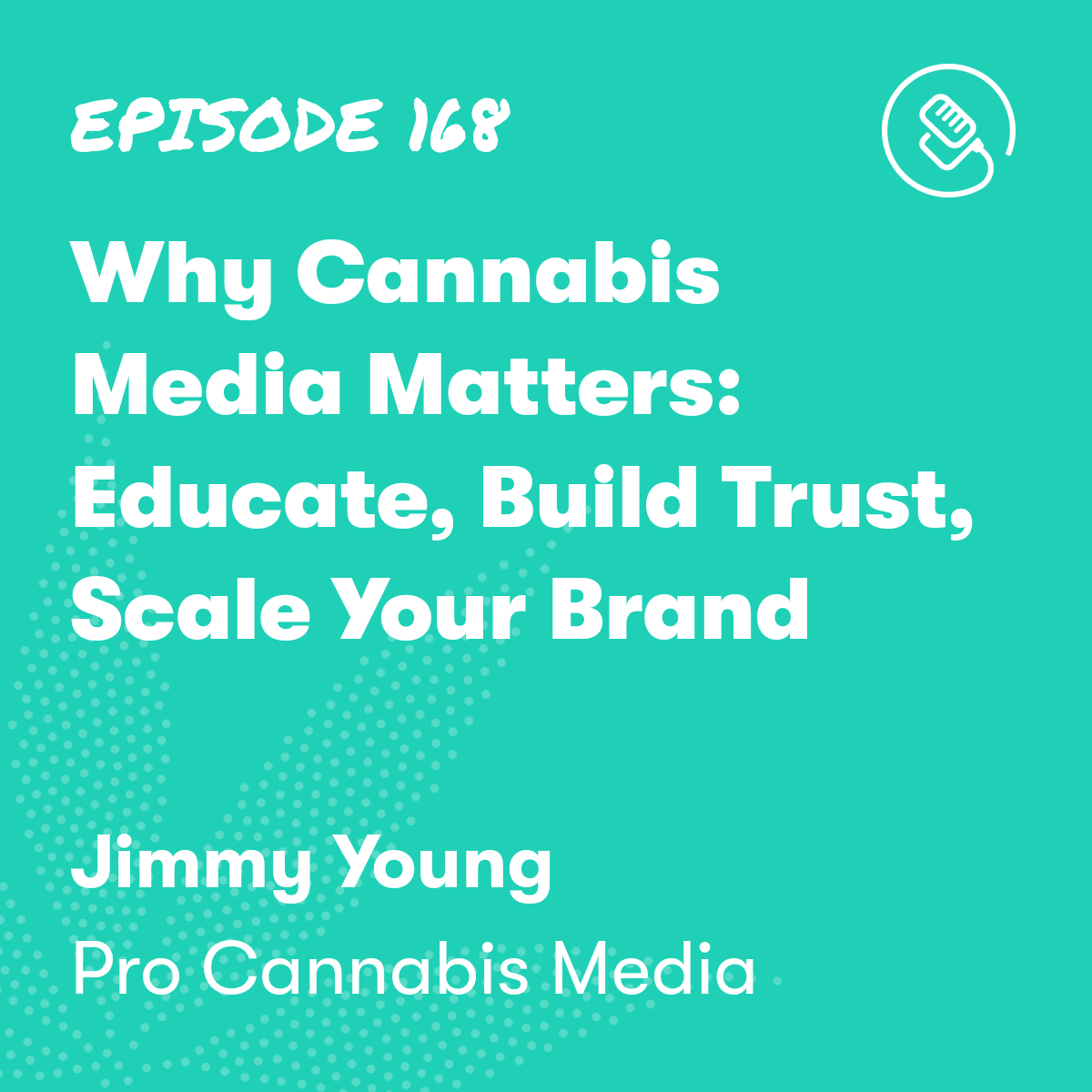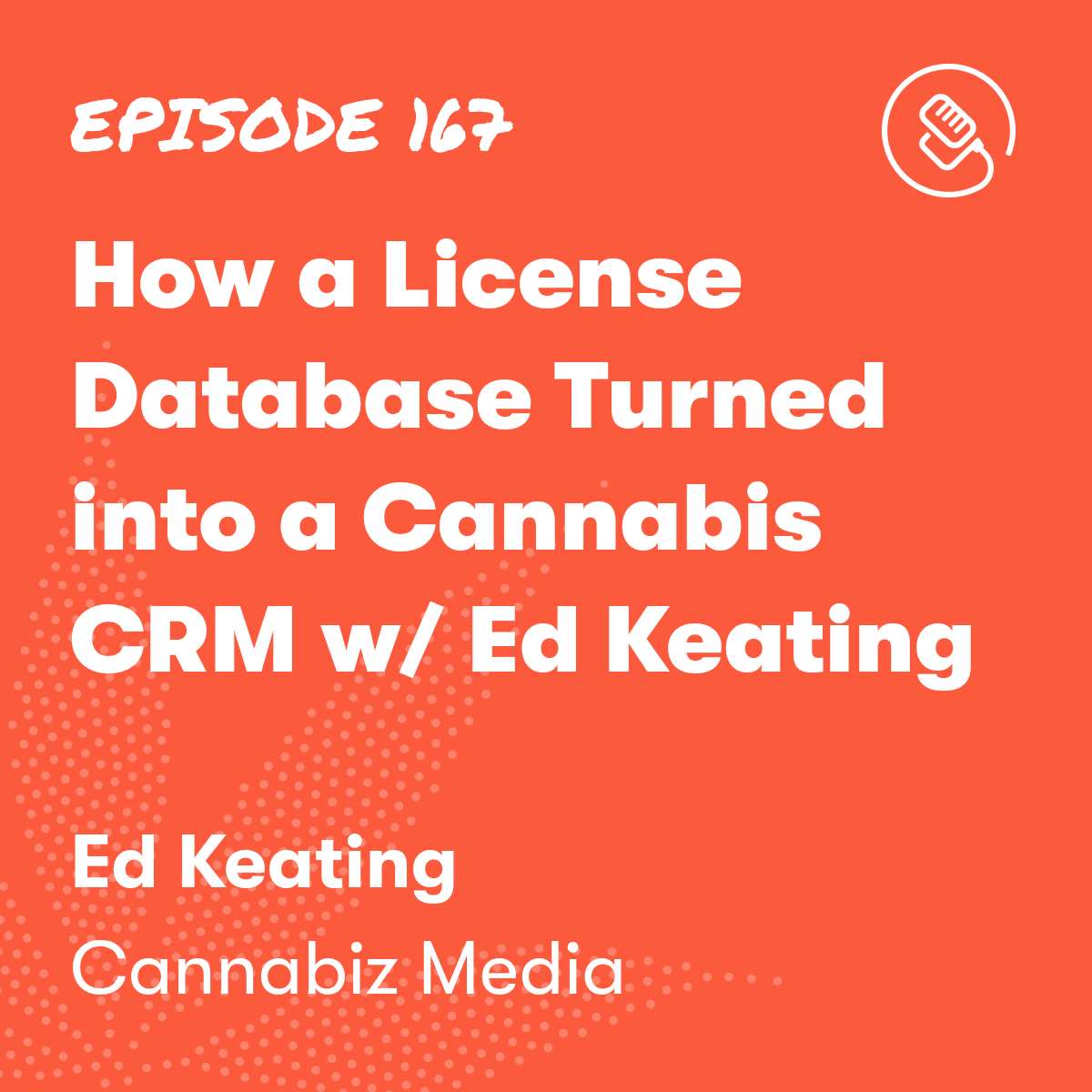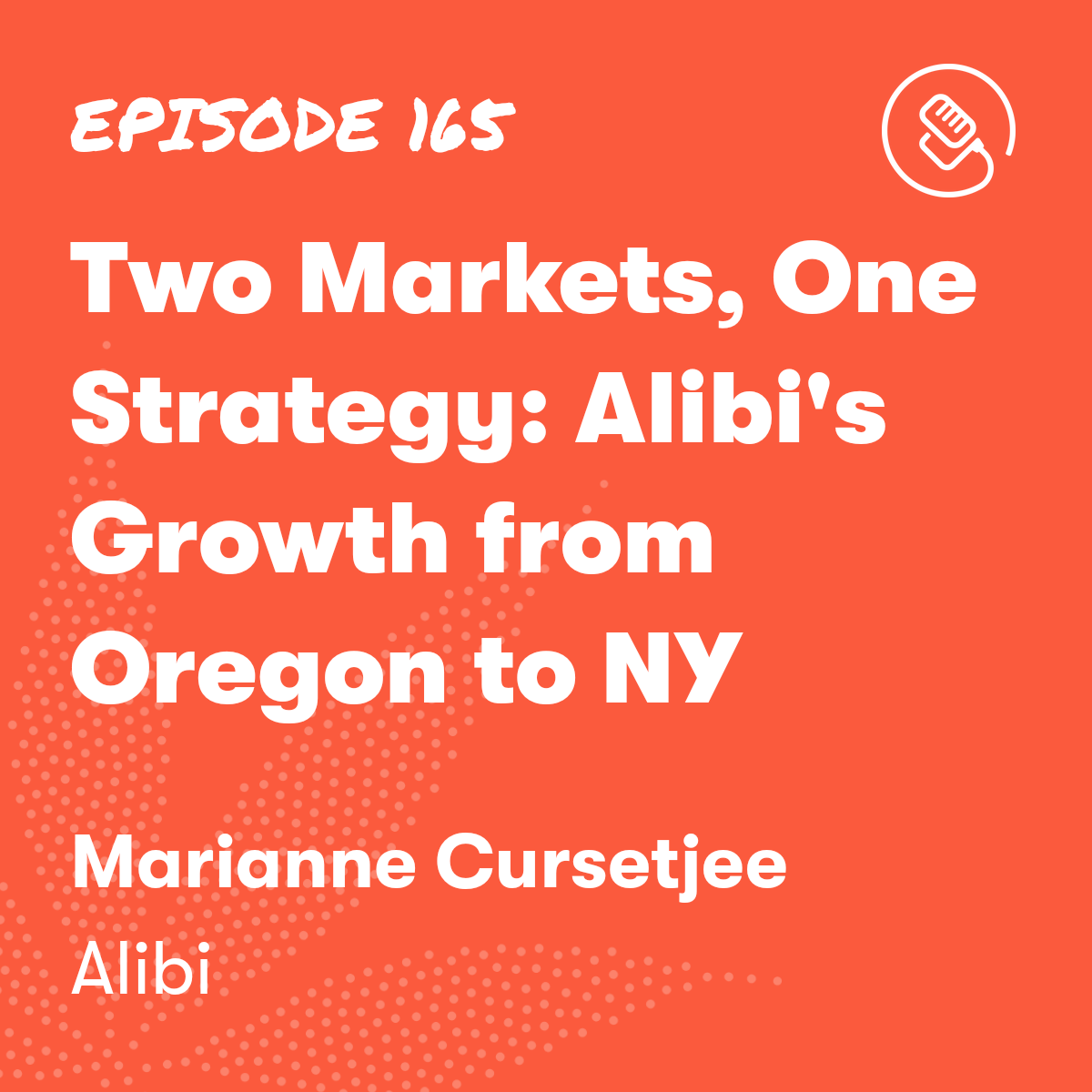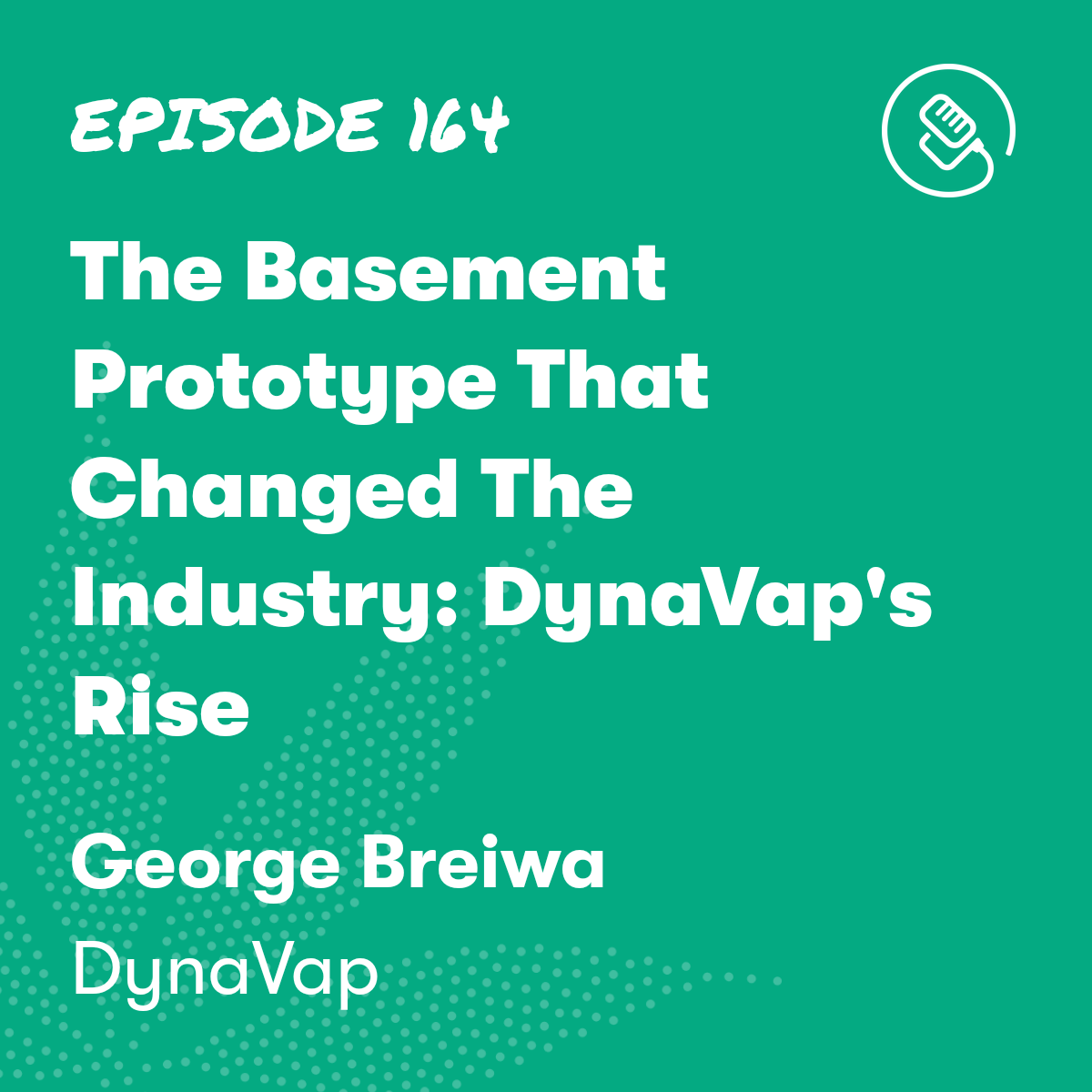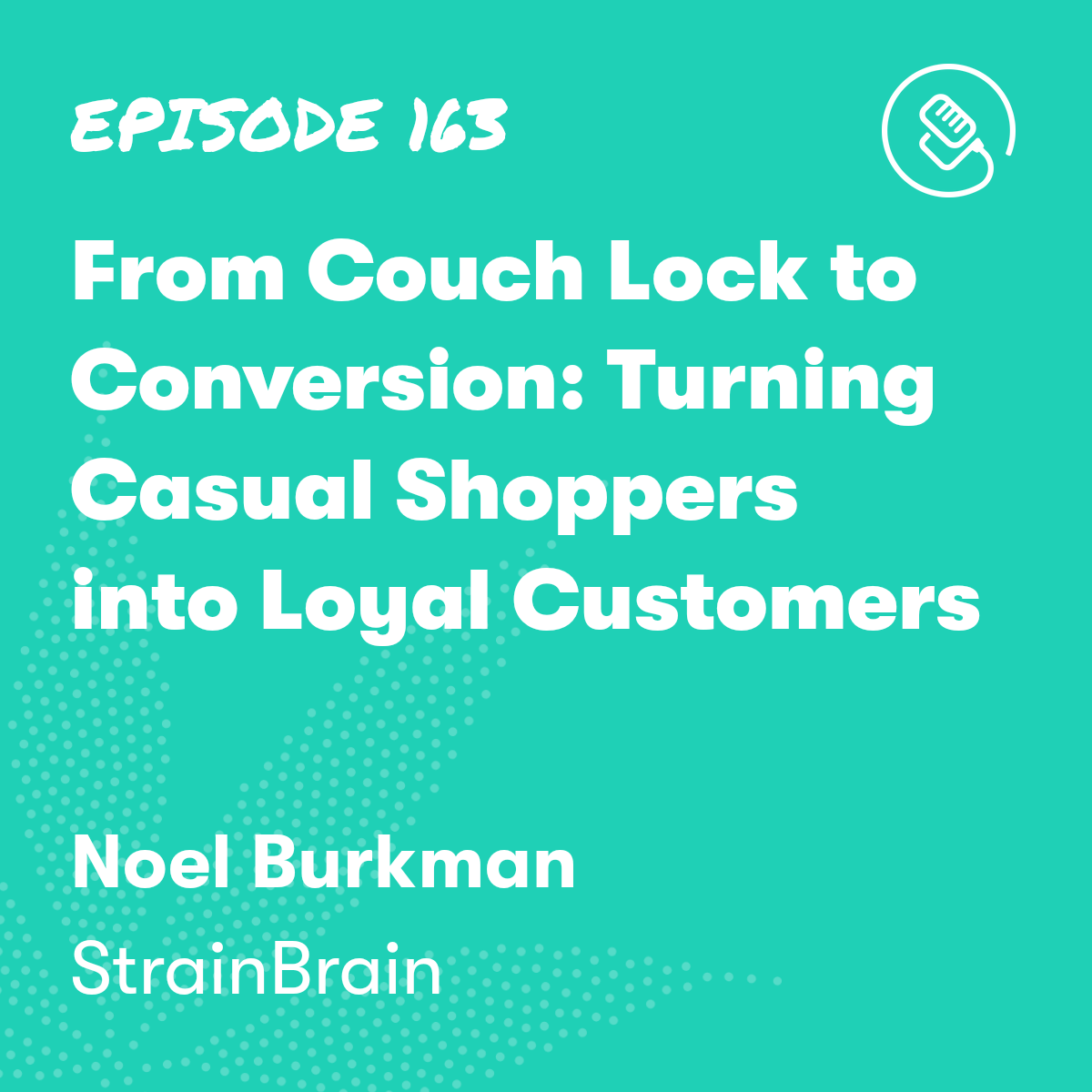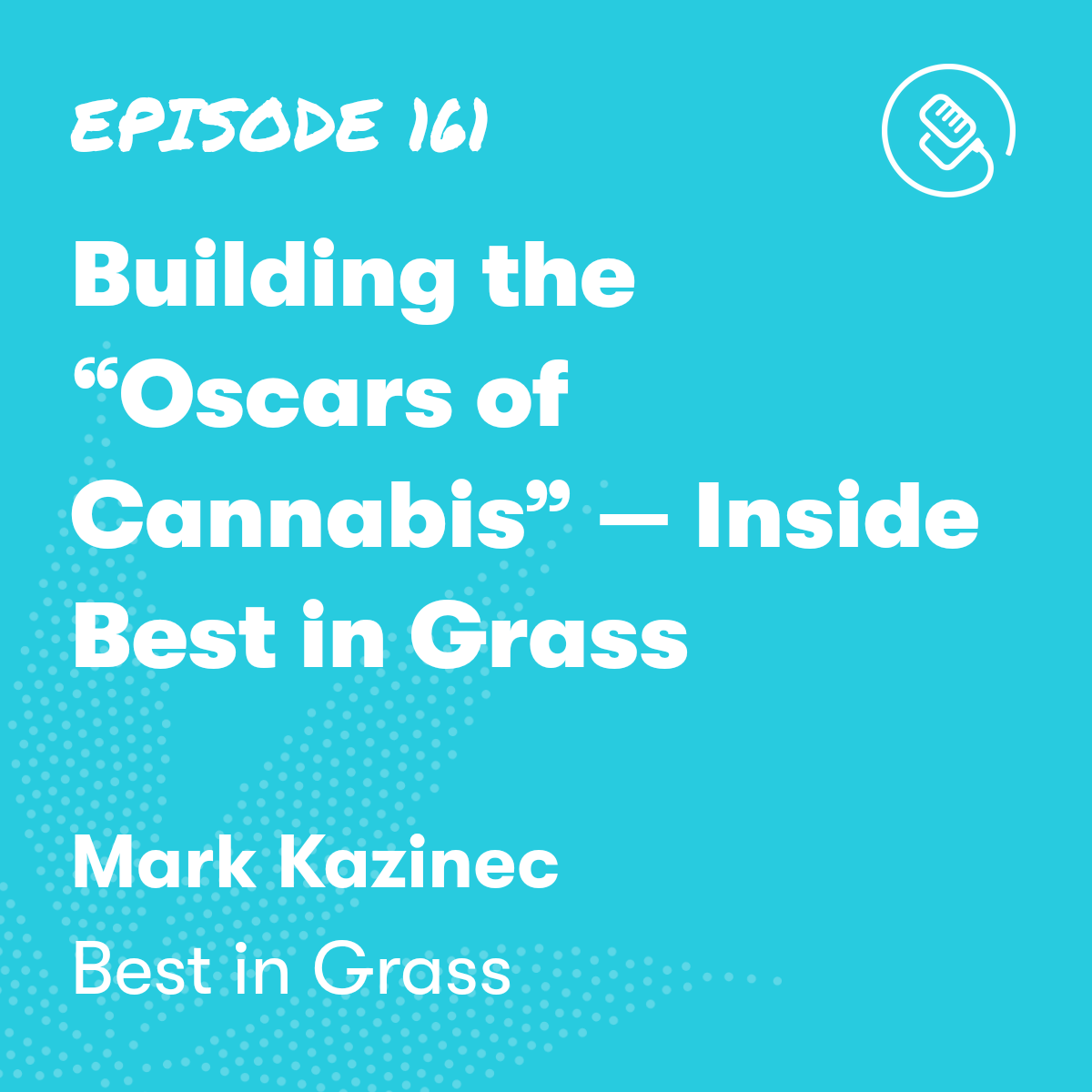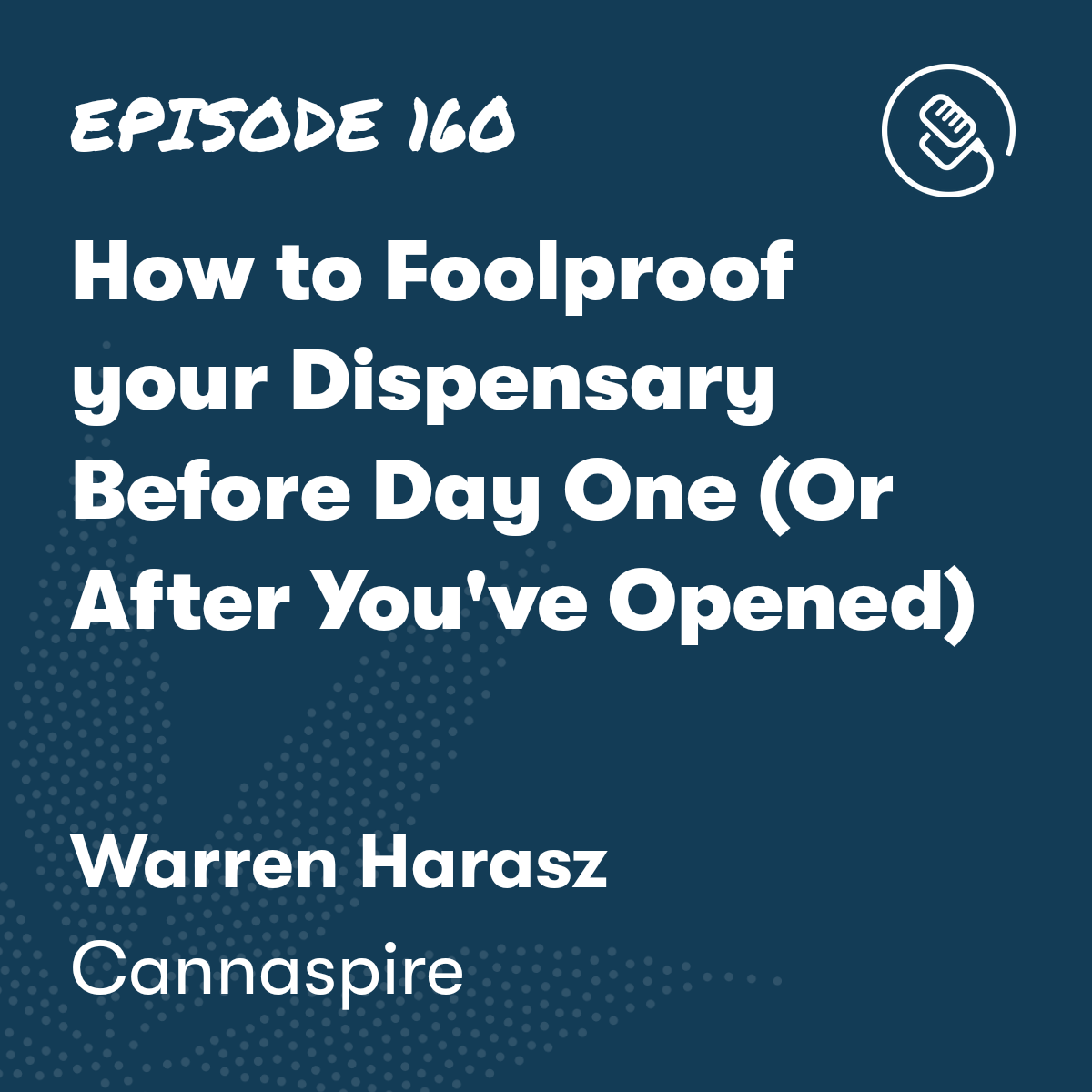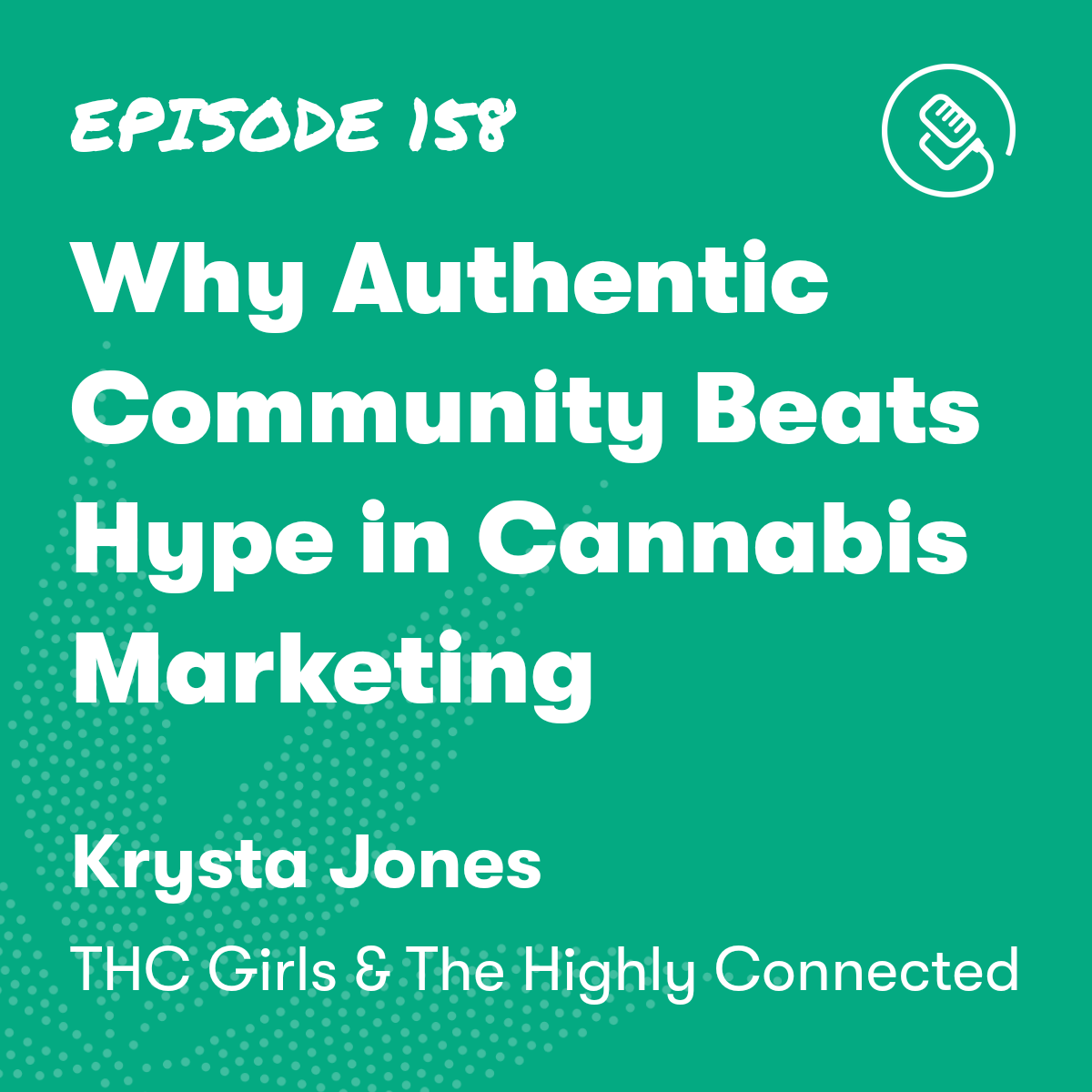

Cannabis Infused Customer Experiences with David Thomas
Episode Description

Episode Transcript
Tom Mulhern: Customer experience is one of the most important aspects of running a retail operation. And this is so true when it comes to cannabis operations, because customers are coming into your store. Maybe they're feeling overwhelmed. And your job as a cannabis retailer is to help people along that journey.
Today on the show, we have David Thomas and he's gonna share some insights what it takes to really create an amazing experience when they walk into your store. And he's utilizing technology to really. Handle some of these problems, these issues, these roadblocks, customer experience and cannabis, retail operations.
So let's jump into our conversation with David Thomas.
Tom Mulhern: David Thomas is the CEO and founder of BudSense and the co-founder of Douglasdale Cannabis in Calgary, Alberta, Canada in 2018. He co-founded Jimmy's Cannabis Shop with his brother, John before selling his company. He's also a partner in Farmer Jane Cannabis Company.
He does so much in 2020 David founded BudSense to help dispensaries with their digital menus, with marketing and so much more. BudSense really makes selling weed easy. They help dispensaries build better menus and sell more weed at the end of the day. So BudSense is a paper and digital cannabis menu and marketing platform for retail cannabis store operators.
I first met. David, when BudSense was demoing their product to Kaya Push. And I heard his story and I saw the, what they had created and I thought, man, we gotta get David on the podcast. So David, I just wanna welcome you here. Welcome to Kaya Cast Podcast.
David Thomas: Hey, Tom. Thanks for having me. Tom had the ultimate touchpoint of calling me out in a zoom call and saying, let's schedule this in. I, I really enjoyed our conversation. On that call because we don't always get to reflect back onto the story in the cannabis industry, just moving so fast that it's nice to just it's nice to just look at it from a different perspective.
So that was really fun, and also just looking forward to the partnership we're building with Kaya. So yeah, happy to here.
Tom Mulhern: Absolutely. So you're talking about story. Tell me a bit of the story of how you got involved in cannabis.
David Thomas: Unexpected. I think is how I would start. And that goes for legalization. I'm Canadian. I'm from Canada, born and raised in Regina, Saskatchewan. I never thought that cannabis would be legal in in north America, let alone Canada paving the way. So that, that kind of took us off guard.
Previous to getting into cannabis. I had a career as an electrical engineer solving problems. And during that as well, I was working with my brother on starting some entrepreneurial efforts, including some real estate commercial real estate management, pretty much anything that we could do to just try and do things a little bit differently and use our strengths.
And then when cannabis legalization came on the map, we just thought, why not? I like cannabis. I like new things. I like innovating. I like business. Let's try it out. We ended up getting the opportunity to open four stores in Saskatchewan. And once we received our permits, We just started learning.
I had purchased cannabis online before, but never really in a store. So we're just, how does this work? How do we start learning start innovating? Go down to Oregon. We start going into all the stores, seeing what everyone's doing.
Little bit excited, overwhelmed all these things, you're seeing things, but you don't have the background knowledge to understand the why. So you're trying to figure out the what without the why.
And the thing that was intriguing to me the most was merchandising, pricing, product information, and the inaccessibility of it. And if you go into a cannabis store more than pretty much any other store, in my opinion, It's hard to find prices on things at the very smallest amount.
That's kinda like the first thing a consumer's looking for. So at the time I was just like, oh, that's weird. I didn't really understand the why, like I said, so we're bringing all that information back and I'm thinking, okay we have to build a merchandising system that we can use remote.
And so that we can create some brand consistency, cuz we were trying to create this brand. And at the time I had no idea, the complexity of cannabis merchandising and product complexity and supply chain and all these things. I just wanted a central located menu system. So we get to work. We start building that I'm working with at the time a consultant , but Andrew Creton and myself are kind of just working through these problems, sitting on the supply room, figuring out what flower is versus a concentrate on how to categorize it.
We know what these products are from a consumer's perspective, not from a supply chain management perspective. So you're building the system. It's pretty complex, but it's me and Andrew sitting in this room, figuring it out. And he's now the CTO of BudSense. So it, it started as this really like small tool for our small business in Saskatchewan.
And what happened was I was just the first customer of, of BudSense. It wasn't called BudSense at the time, but I was asking the dumb questions I was giving the unrealistic expectations. So the feature sets, like I was pushing the product forward. And what we did with BudSense, after we ended up selling our stores and focusing on BudSense was we didn't stop there.
We didn't assume that our small Jimmy's Cannabis Shop knew all the answers. We started to cross pollinate ideas and we started to learn from other people, and we took our hat out of our silo and we looked at all the different markets. And as our customer base grew our ability to learn grew. And then we added cultivators and producers and all these really impactful people that have an opinion that needs to be shared about the cannabis industry and infuse that into the flexibility of our product.
And ultimately at the end of the day, what we are trying to do is create a better consumer experience in a retail cannabis store. So through the consumer's eyes, we are building software that helps retailers makes selling weed easier.
Tom Mulhern: You obviously took your background. Like you said were an electrical engineer before getting into cannabis and that problem solving, I love the fact that you guys really were like, there's not a solution. So let's create one it's ingenious.
David Thomas: That's a thing like, and I was making a couple notes because again, I don't, like they say the entrepreneurs they were focused on the gap. We're not focused on the journey. So like, when you look back, you're like, oh, that's, that was a, this has been a crazy four or five years, at a certain point when I'm telling that story like, there's a clear starting. Us getting the permits to launch this business and then it gets super messy. And it's just because anybody working in the cannabis space right now knows this. You're learning with a fire hose every single day.
The last two years of launching what BudSense, like the actual version of BudSense, commercially available for retailers to use. That's just a blur because every day what we're doing is we're learning and incorporating into the platform and building.
And even though that we're building at a fast rate, For an emerging industry, that's gonna be global before we know it. We can't build fast enough, you know, we just have to come to the realization that this is a marathon. And at certain points we just have to take a breath and kinda align ourselves with where we're at or else we can just get, we get, at least me I get way too deep into these problems.
And then I have to come up for air.
Tom Mulhern: BudSense was created by cannabis retailers for cannabis retailers. And I think that BudSense is really unique in that at least I think so. In the fact that you guys are really an organic cannabis tech company, have there been challenges in building cannabis, specific technology?
You know, a lot of times. Technology's kind of taken from one industry and placed into the cannabis market. Like what sort of challenges or, or benefits have you seen in building that organic cannabis tech?
David Thomas: There's certainly some of both, just to start with some challenges. You're absolutely right. Like usually in a cannabis tech solution, you're pulling the bones of the product from a different industry. And I would say that's easier to create immediate market share.
But that's harder to get to the root of the problem. So I think from our perspective, we have to play the hand that we're dealt and the hand that we're dealt is being really close to the problem and really understanding the problem and then having to start from scratch basically. So turning that kind of negative into a positive.
And then, yeah so the other part of the question is we're a cannabis company first. How does that benefit BudSense? You really don't have to look that far. Just knowing the problems inherently, like going through them, myself. I the biggest thing for me is I know that we're not perfect.
There's too much going on for a cannabis retailer to be perfect. Like you have to pick, you have to pick what you're good at. You have to know what you're bad at and try and make it work. So like knowing we're fighting a losing battle was really valuable. That's just from an operational standpoint, then it's just the cannabis knowledge infused into our product. It doesn't all come from me. I don't pretend to be an expert.
We infuse our entire company, like our whole team, our whole dev team, our whole ops team, everybody, our sales team we go to retail stores. We go to the back room, we know what an inventory management system looks like. We're going to cultivators where we're looking at grow. We're smelling we're smelling the plant, we get the product we're trying to facilitate all these really important voices.
And we're trying to tell the story of each and every product to the end consumer and trying to bridge those gaps. So the cannabis knowledge infuses it, infuses everything really um, pun not intended.
Tom Mulhern: That's where the rubber really meets the road, and so that's so good that company wide, you guys are doing that, getting out there, meeting different, retailers and that's so important to grow that industry knowledge.
This is all great, but what does BudSense do, you know, maybe there's somebody that's new and has isn't aware of what you guys do. So in a nutshell, what do you guys do?
David Thomas: We put prices on products and make product information accessible for the consumer. Our starting point was digital menus. So a digital menu for a cannabis store looks like you have the menu pulling products from your point of sale and displaying them on a digital menu, neither a list or a visual representation simply.
That's what we're doing. We're pulling in stock product and we're merchandising on a digital platform. That's kinda the starting point. We also have paper menus that we can use, and then we're releasing product cards in the near future. So the, what is a digital menu that has products on it? the, The, why is it's challenging to keep that up on a store level.
The complexity of the inventory in cannabis. Is such that it's, it changes there's batch specific data. THC changes from batch products are always new and the cannabis consumer wants new strains. They wanna go on a genetic journey.
Everything is constantly in flux. So typical package goods, a lot of the merchandising support is facilitated by planograms and quarterly strategy seasonal, cannabis doesn't really have seasons yet. It may in the future, but doesn't so your merchandising is happening on the fly in the store.
And if anybody has managed retail before or managed anything on site, they know that your time of sitting or on your computer is very minimum. You're not building out merchandising plans. You're running around, figuring out who's sick, who's coming in. What products are you low on?
Maybe you're dealing with a maintenance manager of the facility. There's a lot going on. So BudSense simplifies all of that merchandising to be able to create success. Now there's some, we can get into some more challenges of that and like the why of flexibility if you want. But that's the root of the problem is that there's not
the attention to detail available in an organization. And it's not really cost effective to use, even if it was available to do a lot of the merchandising. So that's where BudSense comes in and simplifies that and scales it to allow for the retailer to focus on what's important. And that's creating a meaningful customer experience.
Tom Mulhern: And speaking of customer experience. BudSense really enhances that. It sounds like I know when I go into my local dispensary and am looking for a certain thing, it's so confusing, cuz there's all these different strains. There's sativa, indica, CBD, CBN, like all of these things and it can become con so confusing and That experience is so key.
So how is BudSense really enhancing that customer experience?
David Thomas: That's a big one. That's a big question, cuz we could talk about that all day. It's it's the biggest problem. I think the starting point for the conversation is flexibility again, because we're not in the business of telling retailers what to do, but what I do know is that customers have different needs.
So a one size fits all solution, although it works to get it, like that's a great starting. It's not gonna resonate with everybody. So when you're thinking, what are my customer types? I have a visual learner. I have a person who likes to be left alone. I have a person who did all of their research online before they came into the store.
I have a person who wants to chat for 30 minutes. I have a conversation, figure out what works for me. And then I have a person who, who of wants a blend of those things. And then I name five there, but. There's probably 20, 25, you know, there's so many so what we do is we try and create flexible support for the merchandising.
It's not gonna be perfect. When, if we're looking for perfection here, we're probably looking in the wrong spot. We wanna be a cumulative benefit to the customer experience. So if we think a lot of people say well, 80% of the decisions are, are influenced by the bud tenderer and it's like, so, so we don't really need to invest in merchandising.
It's. Okay, that's great. But first of all, how stressful is that for the bud tender? They don't have the tools necessary to help them. And what about the customer who doesn't really wanna talk to anybody? What do they do? And again, there's no one size fits all solution, but let's just look at the scenario where a customer comes into the store.
There's no merchandising, there's no menus. There's no prices on anything. And he is talking to the bud tender. They come to a conclusion of what they're gonna buy. The purchasing decision is made customer purchase the product they leaves revenue goes up. Okay, great. We had a successful transaction, but did we have a successful transaction?
What did we leave off the table? Is that person satisfied? And something is subtle is a menu for both the bud pander and the customer to look at. Yeah, they're still having an engaging conversation, but they can anchor it with visuals.
It's not a simple solution, but it's this cumulative benefit to scalable merchandising systems that you can tune and change at scale to assist in your bud tenderers, who are absolutely the heartbeat of your dispensary.
Tom Mulhern: Yeah, because when customers a going in, there's gonna be a conversation there always is. But leading up to that, you guys really facilitate that time. Like I know I've been waiting in line, like kinda looking, okay, what are the deals today? What are the prices on this? And that facilitates that experience of when I get up there, I at least have a precursor kind of, you know, experience of, okay, this is kind of what I'm looking for as I'm going into to buy whatever it is that I'm buying.
David Thomas: Yeah. Yeah, for sure. And then it's just if we move past that issue okay. We bought in, we have a digital menu in some capacity. It's creating success there's products there that customers like seeing, but what happens when the 10 products that you're displaying is now 20, maybe a new category got launched.
Maybe some innovation happened where you have your demand changes okay. We'll add some more products onto the menu. Now we're at 10 20 30. We have a couple options. We can either shrink the text or we can scroll the menu if we wanted to, but now we've altered the visual representation of the product for the customer.
So what do we do? Like we need flexibility. Do, we can add another screen that has a capital cost . Maybe we add paper menus. Maybe we add a tablet that, that, that works too. Or maybe we change our entire strategy. Maybe we, instead of listing all of the products on the screen, maybe we use that to highlight six products visually to use it as basket builders.
And then we have the core of the menu somewhere else in the store. We could do this all day, it's it's essentially that flexibility piece where it's just let's just be comfortable with the notion. That, what we're doing today is not what we're gonna do tomorrow. And that we are very much in the early stage of recreational cannabis.
We don't really know what we don't really know what a retail experience looks like in five years. And that's what that's what BudSense is really excited about.
Tom Mulhern: As you add more product, you can overwhelm a customer to the point where they're. I don't even know what I want and they just go out. Like one of my favorite restaurants in California is In And Out burger. I don't know if have you been there In and Out?
Oh, I love it, man. I love it so much. And their menu, there's four things to choose from. They have a secret menu, you can get it animal style or whatever, but. Taking away some of that option, as opposed to like the cheesecake factory in the states where there's like a whole like notebook of things you can choose and you get overwhelmed and you don't know what you want.
So really giving them what they need is so important. Now I know your guys' system actually use data to put those products that are really selling, right? Can you talk to that solution of, not just oh, we'll just choose this and this cuz they're the cheapest. How does BudSense kind of use data and like technology to get people with what they need?
David Thomas: That's another layer of the onion, right? So we have these menu type flexibility. Now we're diving into how well, how do we create success within a menu? You said there's a lot of different, flexible ways of how you can position products on a menu. And then just as a starting point, if we think about how do people read and consume information, and you said it perfectly, how much is too much.
And that depends on the reader. Like some readers can digest a lot more than other readers, but when people read they go left to right top to bottom. So inherently the product on the top of the menu is gonna sell more than the product on the bottom of so, so, so we know that for sure.
So when BudSense looks at data and BudSense thinks about this merchandising problem, we don't think reactive data. A lot of the market right now is looking at reactive data. So to say let's look at historical sales data and form our decisions.
The problem with that, even in a complete data set is it's complicated. It's hard to look at other people's data or even your own data and make insights on it. What we choose to do is. We have all these products, where are we going to position and how are we going to position them in the store to most effectively showcase and sell that product?
That's how our data goes from being reactive in nature to we put it on the front end so that we can take the products that we have and know how the tools that we have to sell them. What do we want on the top? What do we want on the bottom?
All the things in between, and in order to do that, we can do things like sort. So do we wanna sort them alphabetically? Do we wanna sort them by price maybe by THC and what is the reason we wanna use that sort? So for price might be a really nice way to start for a value category or maybe a basket building category like edibles.
Maybe you start. Lowest to highest so that it can encourage some basket building, or maybe you're a premium store. Maybe you're doing a premium flower menu, start price highest to lowest value, that price value, that premium product. THC is a whole nother can of worms, right?
If you want it to organize your menu by THC top to bottom, you're gonna sell a lot of the first product. I can tell you that much. But the problem with THC is we get this buying it's happening in Canada right now where people are really drawn to the THC number. And it's frustrating for cultivators and it's frustrating for retailers.
You gotta see it from the consumer's perspective. They don't have many numbers to make their decision and they don't have a ton of brand information. So they have price. They have THC pretty much. So when they're looking at a menu, they're saying like, oh, that price looks low. That THC looks high. And I'm simplifying the consumer.
Right. They're obviously a lot more refined than this, but essentially they're looking at these two numbers. It's like, well, what else, what else can we infuse that menu with? But keep it simple. Like you said, Tom so do we put a badge on there that shows a visual representation of the product?
Maybe it's sour diesel, maybe we put a little gas. Can and a lemon to show that it's a sour diesel, maybe that helps them inform their purchasing decision because they're reminded of that. They, oh yeah. I do like diesel streams. I'm gonna pick that one up or how do we give 'em another number, but terpenes comes up all the time, right?
Terpenes are hard words to say hard words to understand and hard words to remember. So how do we simplify it? Total terpenes is a really nice one. At least it communicate. Something so that they have another number to compare their THC to. So a customer can start saying, okay, maybe this THC number lowered a little bit from what I'm used to, but this total terpene number that communicates value that's significantly higher.
So that probably justifies the premium price. And I'm talking in very layman's terms here, but when we talk about scale, these are the types of subtle changes that will dramatically affect a merchandising strategy over, over multiple store.
Tom Mulhern: And there probably comes into play a lot of training then for bud tenderers, who. Now that they can customize it so much and they can have so many more tools ready to help customers get the product that they are looking for. And that really fits the needs of what they're what they're looking for.
That's really cool.
David Thomas: Bud tenderers are an interesting one for merchandising, because one thing that I, I, I like to remind our retailers about is you're not setting up this merchandising just for the consumer. You're also setting up for the budtender so that they can use it as a tool to sell the product. And then you can also communicate changes to them.
Like it's a lot easier to make change. Informational changes on your menu that can be absorbed by your bud tender. Who's working that shift rather than potentially sending them email communications about new products or whatever. It's much better to infuse your entire customer experience with that product information, rather than kind of like a quiz or a review email, or even a meeting.
Tom Mulhern: What are some of the common requests that you receive from business owners?
Like What are those roadblocks that they're running into that they're coming to you saying, oh, we need your help guys. What can you do to help us?
David Thomas: There's so many, our entire product roadmap is basically built on ideas that our retailers. it's really fun when they start chaining together. So like we, we hear something from one person and then it's echoed and improved from another, and then we take it through our filter and we make it happen.
Cause like when someone comes with an idea they typically don't have the full picture of the, how we're gonna make this into action. But we don't dwell on. We love just getting the ideas. It's constant, like I'll just, I'll just say a couple that we've recently done, but like taxes and pricing.
There's a lot of legacy stores that used to run on cash, you know, and that's changed. And like a lot of the government regulation is now taxes. The pre-tax dollars is pretty much how most of the point of sale systems work. So they wanna merchandise taxes included. We did that. We put that in.
So it's do I want taxes and pricing? Okay, great. Then another one is. Sale emphasis. So something's on sale. How do I show that to the customer? And now when that one's kind of a multi-pronged solution. So we have labels that can say just, it says right next to the product it's on sale.
We can bold the the price. For example. So it showcases just a little bit more we can make the price red. If we wanted to, we can highlight the whole screen or the whole product line. We can make a new product section that automatically pulls in all of the sale prices or all of the items on sale of a certain category.
And then, we'll get a retailer who will say, I love what you did on the text styling of my sale prices. Have you thought of this? And a couple things happen there? It's yes. We've thought of it. And it's on the roadmap.
You'll see it live in X amount of time or no, that's a great idea. Let us stew on. And then we we put it on a whiteboard, we figured it out. Maybe we improve it. Maybe we realize it doesn't work for some reason, but we can modify it a little bit.
So that's our whole process. That's what we're, it's just a big, it's just, we're taking in as much feedback as we possibly can and then integrating it into our solution. So far it's yielded a really a flexible, meaningful product, which is which is really exciting.
Tom Mulhern: Getting that feedback from those dispensary owners, the people that are actually using your product to shape what you guys are doing is key. That's what we try and do it Push it. Constantly seeing how can we improve what we're doing based on the feedback of the people that are actually using it.
And that's how, ideas get better. And it's so cool to see your roadmap just grow and change as cannabis operators infuse their own ideas into what you're creating.
So you're obviously getting a lot of positive feedback as you're, meeting with cannabis operators, but what happens when you get negative feedback? What do you guys do with that.
David Thomas: That actually goes back to our cannabis experience, knowing and retail experience, honestly knowing how challenging it is and knowing the day to day problems of retail and knowing that. The use of BudSense in, even though I value it quite highly, it's usually not the first thing on a, on a manager's list.
They're putting out fires all over the place. So the first thing is being sympathetic to that position. And then understanding how do we create, how do we create a vehicle for them to get support immediately? So what we did is we put a live chat support in our application.
And anytime someone has a problem, it could be their problem. It could be our problem. Something could be broken, something that they might wanna learn about, but anything they can type in their support request into our live support. And it actually goes to our entire team's Slack. So everybody on the team sees.
The support request coming in. So not only can we provide quick efficient support when someone needs help, but we also see problems really quickly. And then we see, so we can see short term near term problems, which might be a bug something's not working. It's software.
It's not always gonna work, so we can fix that. We can get the uptime back, and then we can also learn. So we can learn from those the support requests, because that's oftentimes where we can mine ideas from people. And yeah, like sometimes people are frustrated and we let them be frustrated because they have a challenging job.
And the last thing that they need. Is for us to push them away or not help them or whatnot. So we meet them at the problem and then we help to solve it as fast as possible. And we touched on something there with live support, where we haven't really got into, but BudSense actually has a platform where the retailer can log in.
And that was really important to me because nothing is worse than standing next to a broken menu. And not being able to get ahold of the support or not being able to email the people with BudSense, you can log into the platform and you can make changes. So you can edit names, you can move things around, you can change your merchandising strategies.
And then you can also help ask for help.
Tom Mulhern: You're talking about digital menus and what you're doing there. Talk a bit about your paper, menu solution and how that kind of adds flexibility to what you're doing. Cuz I know, sometimes it's nice to have a paper menu with the sale items and things on it. So how did, how is that kind of adding flexibility to what you guys are doing?
David Thomas: Paper menus have been an interesting journey. You have two things. You mentioned flexibility that there's also the tactile nature of paper menus. That's interesting where people like holding something and they like to be in full control of reading that.
And there's also not an interface with technology, which is, seems to be a little bit rare right now. But people like to feel it, people like to hold it. So that, that that's a big plus, but what really intrigues me on paper menu is the flexibility that, that we were talking about before, because that informs the ability to really do anything.
Like once you bring. You're merchandising away from a fixed digital infrastructure. You're only gonna have so many screens paper. You can have as many acrylic standups, or as many books as you want. And that's just the starting point, really.
So we see this massive increase and the reason is because of the flexibility it provides, you don't have to have all your skews on paper menu. You could have a flyer, you could show some your daily deals. Not only is there that tactical feel about it, but that kind of shows the nuance of BudSense where yes, the paper menu is important, but it's a vehicle for flexibility and that's where BudSense thrives.
So
Tom Mulhern: I know that you're a big geek when it comes to marketing. What are some creative ways that you've seen dispensaries using marketing to grow their business?
David Thomas: Oh, yeah. Creating excitement, I find the first step of cannabis merchandising is putting stuff on the shelf and getting a price on it, and that's challenging in itself, but what we are really trying to put the push the limits on is okay, what do you do after that?
It's like, when's the last time you've gone into a dispensary. And you've been thinking about wanting to buy edible and your mouth is watering. You're thinking of words, liket and lemon drop and and it's, and you're excited because ultimately, like we're selling weed, we're selling a recreational product for someone to go home and watch a movie or go for a walk, or spend a day at the beach.
Like it's exciting. It's fun. The other thing is let's create excitement around deals about basket building. So daily deals was one that I mentioned, which is really cool. Where, you have like a happy hour or something where your pre-rolls are 10% off. Make a day different, like just choose a day, create a special run with it. And then the other thing is flexibility in the store. You asked, how do we market better? So let's think of McDonald's right. They have a drive through, they have the counter.
And then they have an app that you can do pickup and they have that kiosk that you can order from. And then within that, they have all these other menu structures and that's, McDonald's where you probably know what you're gonna order before you even walk in. So for dispensary, like we better at least have a couple merchandising options to attract the customer and have fun.
My, my favorite marketing in cannabis is how do we have fun? There's one store I saw in LA. They have a bunch of clones growing in the store. There's this glass room in the middle of the dispensary with a bunch of clones. And it's like, yeah, this is a plant.
After all, like the government makes us the government regulations usually make us package it up and put it in the little container. But like, yeah, let's remind ourself where, where it's coming from and have a little bit of fun with it. That's where I see marketing.
Tom Mulhern: Like you said, they're selling an experience really at the end of the day at a dispensary, you're selling an experience, whatever type of experience the user. So buying, it should be an experience too, an experience of joy and delight. And I love that idea of mouthwatering, like going in there then there's like lemonades and all these different things.
So it should be an experience shopping. So using marketing to create that experience for customers is so key. And it's awesome to see you guys utilizing technology and to just create some of that joy and delight.
David Thomas: The real experience is when that consumer gets the product home, unbox it and gets to use it. And then. Our influence in that is what did we do to excite them for that?
What did we do for, to prepare them for that? What do they know about the product that they're gonna consume and what are their expectations? If we can meet or exceed their expectations by the story that we've created around the product that they took home, that's where we really win.
Let's go granular. Let's focus on the product we need to ensure every product that someone's buying. They at least have a fraction of the story to improve their consumption experience.
And that's ultimately, what's gonna keep them coming back. The tree in the middle of the dispensary is cool, but if they're not getting a satisfactory product experience they're losing. And the funny thing is they could try the same product from two different stores and either love it or hate it, depending on how they were prepped for the experience that they were gonna enjoy at the end of the.
Tom Mulhern: And they'll tell that story to their friends and family, whatever the story. Are hoping for like, oh, I couldn't sleep. And I started using, you know, CBD and I was able to sleep. They'll tell that story if you're able to sell that story. So that's so key for business owners. Keep that in mind as you're, you know, running your business.
What's one of the things that's really surprised you about working in the cannabis industry?
David Thomas: My biggest one is that it exists. I know it's a lame answer, but I didn't think we'd be here.
My surprise is being exposed to the cannabis world in a way that I didn't even know it existed. The amount of people that I have met that have poured their life into this industry is humbling and inspiring like everywhere you look, glass blowers, cultivators, producers.
It's remarkable. It's humbling like this is why I care so much about merchandising because at the end of the day, there's this big gap between what's in the store and what's in the ground.
We need to at least attempt to facilitate that story from the grower to the consumer, and we can do that via menus. I'm blown away by the depth of the industry. I feel like it's my obligation to, to use BudSense. Fill as many of those gaps as we and tell as many of those stories as we can.
Tom Mulhern: So we didn't really get into your story too, in depth about being a dispensary owner, but as a dispensary owner, what is one tip you can give to the other owners out there to grow their business?
David Thomas: One quick tip be comfortable with failure,
no matter what you're gonna make mistakes. So at least try to bake some flexibility into your plan and don't spend your full budget on day one. You're gonna have to make modifications to your space. And it's just inevitable. So try a lot of things be comfortable with trying, but then what's even more important is trimming what doesn't work.
So when you're starting from zero and you're trying a bunch, inevitably, stuff's gonna not work. Even if you hit 90%, you gotta cut that 10%, because if you don't, you got a bloated system. And your, your operation will fall apart and you'll be really stressed. So be comfortable with change. Be comfortable with making mistakes, be as flexible as you possibly can.
And give yourself a break it's hard, but it's rewarding and you have time to make mistakes and learn because we are at the infancy of the of recreational cannabis. We all have so much to learn. It's a long journey ahead.
Tom Mulhern: So how can our listeners find out more about you and the work you're doing at BudSense? Or if they're looking at their current solution for their customer experience and. I need to step this up. How can people find out more about you David?
David Thomas: If you wanna track me down, the best place is probably LinkedIn. Follow me, David Thomas on LinkedIn. Send me a DM. love talking about new dispensaries old dispensaries plans. It doesn't always have to include BudSense, but sense is just a tool. We can talk about your goals and figure out where you're going and I'm happy.
I'm happy to share any advice that I can how to learn more about BudSense best way is to find us on our website. It's mybudSense.com. You can explore some of the blogs , and then also just request a demo. So go to our about page, request a demo, and you'll be able to schedule it right on there.
And and we'll get in touch
Tom Mulhern: I'd encourage all the listeners to just go check out myBudSense.com and uh, thank you so much for taking this time to chat and to really talk about creative ways to help customers get what they need and to share what you guys are doing. So thanks for being on the show.
David Thomas: Thanks, Tom. Really happy to be here. And uh, thank thanks for the invite I had. I had a blast.
Tom Mulhern: David really shared so many great insights for cannabis retailers in how to market yourself and how of cannabis with your customers. Like I said, we're selling an experience and being able to be experts in what you're selling, being experts in that And so again, I wanna thank David for coming on the show and encourage you to go check out BudSense and the solutions they have for cannabis, retail, operations, to really make your customer experience better.

